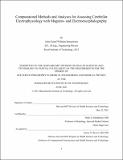Computational Methods and Analyses for Assessing Cerebellar Electrophysiology with Magneto- and Electroencephalography
Author(s)
Samuelsson, John Gustaf Wilhelm
DownloadThesis PDF (8.928Mb)
Advisor
Hämäläinen, Matti
Terms of use
Metadata
Show full item recordAbstract
The cerebellum contains almost 80 % of all neurons in the human brain and is now recognized as a critical node in the distributed neural circuits underlying autonomic, sensorimotor, cognitive, and emotional functions. Cerebellar dysfunction has furthermore been implicated in some of the most prevalent neuropsychiatric diseases including autism and schizophrenia, with new information implicating the cerebellum in neurodegenerative dementias and Parkinson's disease as well.
Despite advances in our understanding of cerebellar structure and function on the microscopic scale, and an increasing number of hemodynamic functional imaging studies, the macroscopic scale electrophysiology of the cerebellum remains poorly characterized. Magneto- and electroencephalography (M/EEG) can non-invasively and directly measure neural activity at sub-millisecond temporal resolution and therefore hold promise to bridge this gap. M/EEG has, however, so far mainly been employed to study the cerebral cortex and its use in the study of cerebellar electrophysiology is largely unexplored.
This thesis presents a comprehensive investigation on assessing cerebellar neural activity with M/EEG. First, a new technique that allows for reconstruction of the cerebellar cortex from standard-resolution in-vivo MRI data is presented. This technique is used to create a surface source space and quantify the detectability of neural activity in the cerebellum with M/EEG. We then develop a novel analytical framework to compare the performance of source estimators and quantify the spatial fidelity of the cerebellar source estimates that are attainable using our new cerebellar source space tools. The proposed methods and analyses assume only standard MRI and M/EEG data. They are therefore readily applicable and thus enable a new and efficient way of studying cerebellar electrophysiology in health and disease.
Date issued
2021-06Department
Harvard-MIT Program in Health Sciences and TechnologyPublisher
Massachusetts Institute of Technology